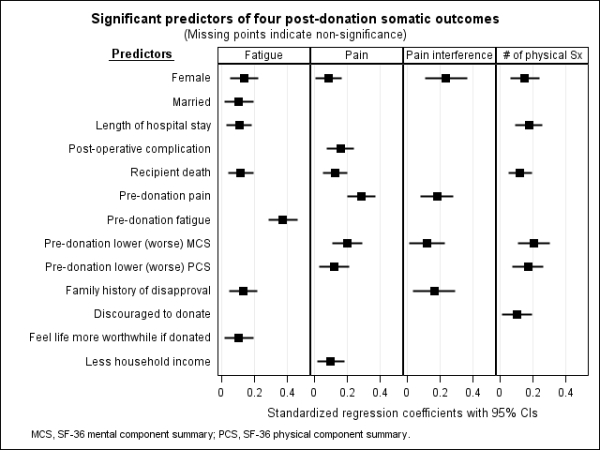Fatigue, Pain, and Other Physical Symptoms of Living Liver Donors.
Z. Butt,1 A. DiMartini,2 Q. Liu,3 M. Simpson,4 A. Smith,3,5 J. Zee,3 B. Gillespie,5 S. Holtzman,6 D. Ladner,1 K. Olthoff,7 R. Fisher,8 S. Hafliger,9 C. Freise,10 M. Mandell,11 M. Dew.2
1Northwestern U, Chicago
2U of Pittsburgh, Pittsburgh
3Arbor Research Collaborative for Health, Ann Arbor
4Lahey, Burlington
5U of Michigan, Ann Arbor
6U of Toronto, Toronto, Canada
7U of Pennslyvania, Philadelphia
8Virginia Commonwealth U, Richmond
9Columbia U, New York
10U of California at San Francisco, San Francisco
11U of Colorado, Denver.
Meeting: 2016 American Transplant Congress
Abstract number: A214
Keywords: Living-related liver donors, Quality of life
Session Information
Session Name: Poster Session A: Living Donor Liver Transplantation
Session Type: Poster Session
Date: Saturday, June 11, 2016
Session Time: 5:30pm-7:30pm
 Presentation Time: 5:30pm-7:30pm
Presentation Time: 5:30pm-7:30pm
Location: Halls C&D
Background: Post-operative pain and fatigue can be significant for some living liver donors (LLD). A better appreciation of these outcomes may inform pre-donation education and post-transplant support. Our purpose was to evaluate fatigue, pain, and other somatic outcomes of LLD.
Methods: We collected prospective data (pre-donation, 3, 6, 12 and 24 mo post-donation) from 271 LLD at 9 centers in the Adult to Adult Living Donor Liver Transplantation Cohort Study (A2ALL), using validated health related quality of life measures. Repeated measures regression models identified demographic, clinical and psychosocial predictors of outcomes (see Fig 1).
Results: Few LLD reported significant fatigue, abdominal or back pain, or pain interference, and <10% reported moderate to severe pain. Perceptions of physical symptoms worsened from pre-donation to 3 mo post-donation and somewhat recovered by 24 mo. Significant predictors (p<0.05) of fatigue, post-donation pain, pain interference and the number of physical symptoms attributed to donation (# of physical Sx) are shown in Fig 1, with standardized regression coefficients to show direction and relative size of effects. Recipient death, female sex, longer donation hospital stay, pre-donation pain, lower MCS, lower PCS and family history of disapproval predicted two or more outcomes.
Conclusion: LLD report worsening fatigue and pain immediately after surgery that approaches pre-donation levels by 24 mo post-donation. LLD at risk for physical morbidity, particularly female donors, those whose recipient died, and those with a longer hospital stay, may benefit from additional post-donation support.

CITATION INFORMATION: Butt Z, DiMartini A, Liu Q, Simpson M, Smith A, Zee J, Gillespie B, Holtzman S, Ladner D, Olthoff K, Fisher R, Hafliger S, Freise C, Mandell M, Dew M. Fatigue, Pain, and Other Physical Symptoms of Living Liver Donors. Am J Transplant. 2016;16 (suppl 3).
To cite this abstract in AMA style:
Butt Z, DiMartini A, Liu Q, Simpson M, Smith A, Zee J, Gillespie B, Holtzman S, Ladner D, Olthoff K, Fisher R, Hafliger S, Freise C, Mandell M, Dew M. Fatigue, Pain, and Other Physical Symptoms of Living Liver Donors. [abstract]. Am J Transplant. 2016; 16 (suppl 3). https://atcmeetingabstracts.com/abstract/fatigue-pain-and-other-physical-symptoms-of-living-liver-donors/. Accessed January 7, 2026.« Back to 2016 American Transplant Congress
